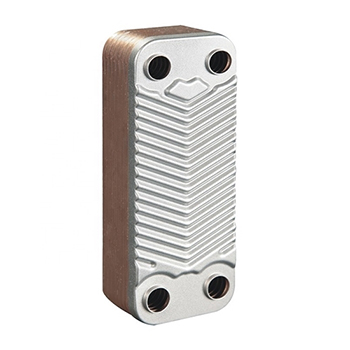What is a Heat Exchanger?
Heat exchanger equipment is a device used to transfer heat from hot fluid to cold fluid to meet the specified process requirements. It is an industrial application of convective heat transfer and heat conduction. Next, ATO will introduce the types, principles and applications of heat exchangers for you.
Application
In petroleum, chemical, light industry, pharmaceutical, energy and other industrial production, heat exchangers are often used to heat low-temperature fluids or cool high-temperature fluids, vaporize liquids into steam or condense steam into liquids. The heat exchanger is not only a unit of equipment, such as heaters, coolers and condensers, but also an integral part of a certain process equipment, such as the heat exchanger in the ammonia synthesis tower. Heat exchanger is an important unit equipment in chemical production. According to statistics, the tonnage of heat exchanger accounts for about 20% of the entire process equipment, and some even as high as 30%. Its importance can be imagined.
Type of heat exchanger
Heat exchangers can be classified in different ways. According to its operation process, it can be divided into three types: partition type, hybrid type, and heat storage type; according to the compactness of its surface, it can be divided into two types: compact type and non-compact type.
A heat exchanger usually consists of three parts: the architecture of the heat exchanger, the heat transfer, and the fluid flow mechanism. The heat exchanger architecture consists of several heat exchangers and pipes, the heat exchanger consists of several heat exchanger units, and the fluid flow mechanism consists of pumps and pipes.
Working principle
The working principle of a heat exchanger can be divided into two steps: thermal energy transfer and fluid flow. In the heat energy transfer step, heat energy is transferred to another fluid through heat conduction between the heat exchanger units in the heat exchanger, thereby realizing energy saving and utilization. In the fluid flow step, the fluid flow mechanism makes the heat energy transfer between the two fluids more smooth and makes the heat energy transfer between the heat exchanger units in the heat transfer device more efficient.
When the medium passes through the surface of the vortex tube, it strongly scours the surface of the tube, thereby improving the heat exchange efficiency. This structure realizes the functions of corrosion resistance, high-temperature resistance, high-pressure resistance, and anti-scaling. The fluid channels of other types of heat exchangers are in the form of fixed-direction flow, which forms a bypass flow on the surface of the heat exchange tube, and the convective heat transfer coefficient is reduced.
Features of the heat exchanger
Two-way ventilation: Indoor and outdoor two-way ventilation, equal replacement of fresh air and exhaust air, and positive and negative pressure operation of brazed plate air-to-air heat exchanger can be realized according to customer requirements. Fresh air and exhaust air are completely separated to completely avoid cross-infection.
Filtration: Equipped with different filter materials, the fresh air filtration treatment can effectively purify the air and meet the requirements of building regulations. Equipped with different filters can effectively prevent pollutants such as dust and harmful gases from entering the room. Medium and high-efficiency filters can be configured according to cleanliness requirements.
High efficiency and energy saving: Built-in static heat exchanger, the heat exchange efficiency is greater than 70%. The cooling and heating load (room temperature) is not affected by fresh air, which greatly reduces the energy required for fresh air to achieve high efficiency and energy saving.
Easy to apply: A variety of water-to-air brazed heat exchanger models are suitable for building units ranging from 15 square meters to 1,100 square meters. Integrated structure, built-in heat exchanger, double fan, filter. It can be used only by connecting the power supply and the air outlet, which not only simplifies the design but also adapts to various renovation projects.
Safe and reliable: Low-noise fan and internal noise-reduction treatment prevent disturbance to the site. The whole machine has no moving parts except the fan and requires almost no maintenance, which can ensure long-term stable and reliable operation.
Low cost and high benefit: Instead of fresh air treatment equipment, there is no need to set up a separate operation room, which can reduce equipment investment and construction area, and use heat recovery technology to save energy and reduce consumption. Significantly reduce operating costs, save more than 30% of energy consumption for fresh air treatment, and have no cold and heat source supply. The integrated structure reduces maintenance workload and saves labor costs.
Cleaning method
Manual descaling: As the name suggests, it is to manually use tools to clean the surface of the heat exchange medium, that is to say, to use flat shovels and wire brushes to peel off the scale surface damage.
Chemical descaling: add chemical agents to dissolve and peel off the dirt, which has the advantages of short time and thorough descaling. The disadvantage is that the chemicals used for cleaning may easily cause reverse corrosion if improperly operated, and in order to avoid environmental pollution after the chemical reaction occurs, the treatment of cleaning waste liquid is particularly important. In addition, when the tube side or shell side of the heat exchanger has been completely blocked by dirt, it is difficult to remove the carbonized scale. It is not difficult to see that the way of chemical cleaning and descaling has great limitations and professionalism.
Mechanical descaling: The way of mechanical cleaning is to use physical methods to wash and crush dirt. It does not use chemicals and does not produce waste liquid treatment and other problems, such as high-pressure water jet cleaning, sandblasting cleaning, etc.

